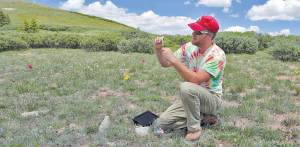by George Sibley
Western legend carries the vignette of the Indian talking to the boss of a wagon train on the Oregon Trail. “How many of you will there be?” the Indian asks.
The story is probably apocryphal, but it’s a good question, especially for a state that has already started to feel crowded despite a lot of open space. Reputable population projections suggest that the population might as much as double by the time the kids now in grade school are running the society.
“Carrying capacity” is a term natural and social scientists use to describe the maximum population of a species that a given environment can sustain by providing that population with the essential food, water, fuel, habitat and other things the population needs for its continued survival. We have seen what happens to species that get “released” from natural constraints by the disappearance of a predator or some other competing species and become a “swarming species,” exceeding the carrying capacity of their environment. The passenger pigeon that flew in sky-darkening flocks in the 19th century, then disappeared entirely in the early 20th century; the lemmings who swarm less dramatically but more frequently, then disperse frantically in all directions (although not over cliffs unless pushed by Disney movie crews).
The question today, though, is about us. Are we a swarming species on the planet? Our global population passed seven billion a couple years ago, and is projected to reach 9.6 billion by mid-century, with a growing percentage anticipating a “more American” standard of living. Does the planet have the carrying capacity for that? Or bringing it home – do the plains and mountains of Colorado have the carrying capacity to support 3 to 5 million more people by mid-century, all expecting to live like Americans do today or better? It is a very relevant question today to Colorado’s several hundred amateur water planners – water being an obvious factor in carrying capacity for semiarid regions.
Trying to put the swarming question into the context of the natural history of the species, I think the answer is “yes, but.” Yes, humankind has become a swarm on the planet – and has been so for many millennia. But, we have applied some unique genetic gifts to the problem of carrying capacity, and so far we are managing to increase the carrying capacity of our environments (for ourselves), thus avoiding (or at least pushing back) the population crash that befalls other swarming species.
We humans began to swarm globally around 10,000-15,000 years ago, when the Big Ice last retreated, and the global climate moderated. Suddenly (relatively speaking) more humans, from babies to elders, were surviving the diminished rigors imposed by nature. This gladsome situation, however, began to have less happy consequences. The basic social organization for humans then was the hunter-forager band, clan-based groups ranging from a couple dozen to as many as a hundred people, depending on the richness of their environment, and each band required many square miles of territory for its food resources. But as populations grew within the bands, conflicts emerged between and within the groups, since their territorial environments did not expand accordingly. Archaeologist Stephen LeBlanc told that story for our neighborhood in his book, Prehistoric Warfare in the American Southwest (University of Utah Press, 1999). But it is a story that happened around the world as the climate mellowed and human populations grew.
Had human behavior been “hardwired” in us like most instinctual animal behavior, that warfare, along with the other three apocalyptic horsemen that ride with war, would have eventually brought the human population back into balance with the land’s carrying capacity for hunters and foragers. But we had become a cultural animal with a big brain capable of critical and creative thought. We responded to the carrying capacity challenge by thoroughly changing our fundamental cultural relationship with our environments. We could see that we needed a larger food supply for the band, from roughly the same resource base, and we needed it to be concentrated in defensible spaces. So hunters became herders, protecting the animals they lived off of from other human groups (and from other predators flourishing in the mellowed climate). And foragers became farmers, collecting and planting seeds in protectable places where they would also grow well. Permanent villages replaced the moveable feast that had followed food-seasons around the landscape.
It was more hard work for everyone, but these radical cultural changes significantly increased the carrying capacity (for humans) of most environments occupied by humans. The new agrarian culture (“agri-culture”) significantly increased the food supply – and continued to do so as farmers and herders learned more about selective breeding in plants and animals. Surpluses were produced, creating new tasks, such as production of pots for storage.
In fact, the cultural transition to herding and farming worked so well, to sustain previously unsustainable populations that within a few millennia, carrying capacity again began to be an issue. With food production more dependable, storable surpluses enabling survival through bad years, and no predators other than microbes and other humans, populations continued to expand, eventually maxing out the capacity of the agrarian village model. Another major cultural leap in social organization was needed, and inventive humans came up with one: the city-state. Much larger numbers of people needed to be pulled together and reorganized, not around villages where everyone was doing roughly the same thing on a small scale, but in a society organized around large-scale projects with new and different jobs that needed to be done in a coordinated way.
Large floodplains could be made productive through irrigation, but irrigation required tools, laborers, maintenance, and most important, technical knowledge and managerial skills. Building materials (mud bricks, wood beams), construction and fuel wood became essential industries, and as those new specialized industries for supporting food production emerged, new economic systems for food distribution had to be developed. “Elites” emerged around the necessary functions of management, design, construction and engineering, and the internal economic systems. Overall, management has historically been as “hierophantic” as hierarchical – in the hands of a priestcraft for local gods that were manifestations of the internal forces binding and driving the city itself.
This transition from “agri-cultures” to “agri-civilizations” worked to the extent that the food supply again expanded enough to feed many more mouths – and the mouths, of course, expanded accordingly. Many hands required much work, the idle mind and hand being the devil’s playground. Armies came into being as a way to corral and channel young testosterone that might otherwise revert to band behavior (know in cities as “gang behavior”). And massive “public works” projects were devised to put people to work – ziggurats, pyramids, hanging gardens, ceremonial stadiums, interstate highways and so on.
The intensity and complexity of the “agri-civilization” project, however, has historically always proven to be its vulnerability: deterioration in complex irrigation systems, energy crises (usually running out of accessible wood), other resource pressures – but probably also the kind of ennui that settles over a mass culture in which everyone is a cog in the machine but few really have the big picture. The MEGO problem (My Eyes Glaze Over) happens when someone tries to explain a complex problem and its possible complex solutions.
This process of a more intensively structured human society began around 6,000 years ago in major river floodplains around the world – six millennia of “civilizations” rising, stumbling, sometimes crashing and sometimes just ebbing back into feudal agri-cultures, then rising again as human numbers necessitated, often on the ruins of older civilizations. Anthropologist David Stuart wrote a comprehensive overview of that process being worked through near here – and ultimately failing – in his wonderful Anasazi America (University of New Mexico, 2000).
It is not hard to see us still trying to make that process work today, globally, where a still-swarming human population is being gathered in larger urban concentrations than ever dreamed of 6,000 years ago. American history can be read as the whole process from hunter-forager culture to civilization compressed into three centuries of mostly civil war between the hunter-forager natives, the Jeffersonian agrarians trying to escape out in front of civilization on the European industrial model, and the European industrial civilization itself rolling forward with imperial inevitability.
In the contexts of that interpretation of our history, places like Central Colorado today are just scattered remnant pockets of the agrarian stage in the evolution of our efforts to sustain the swarm. It is already mostly co-opted by the great city and its need to run our resources through its machinery for making more food for more people from the same land and resource base.
The journal “Science” recently published the results of a University of Minnesota study on the potential for increasing food production on existing farmed land – which is pretty much all the farmable land there is. The study essentially sees greater efficiency in food production, and food distribution as most of the challenge, including big changes in food production like less production for fattening animals and more for direct human consumption. It is hard to imagine that happening without a much more hierarchical and top-down political and economic structure. Things like Colorado water law, rural connectivity (electricity, broadband, gas lines, etc.), and democracy are not efficient.
The question becomes how much longer – even with a currently unimaginable benevolent authoritarian super-efficiency – can we continue to feed the swarm, and the growing appetites of the swarm, before some equally unimaginable natural controls step in and bring the whole mess crashing down? (Don’t think about climate change.)
George Sibley writes from Gunnison, where he may be spending too much time thinking about water and the future.



